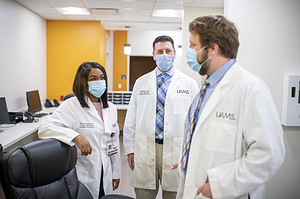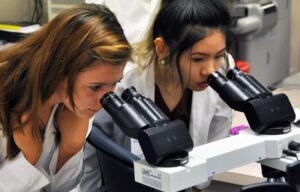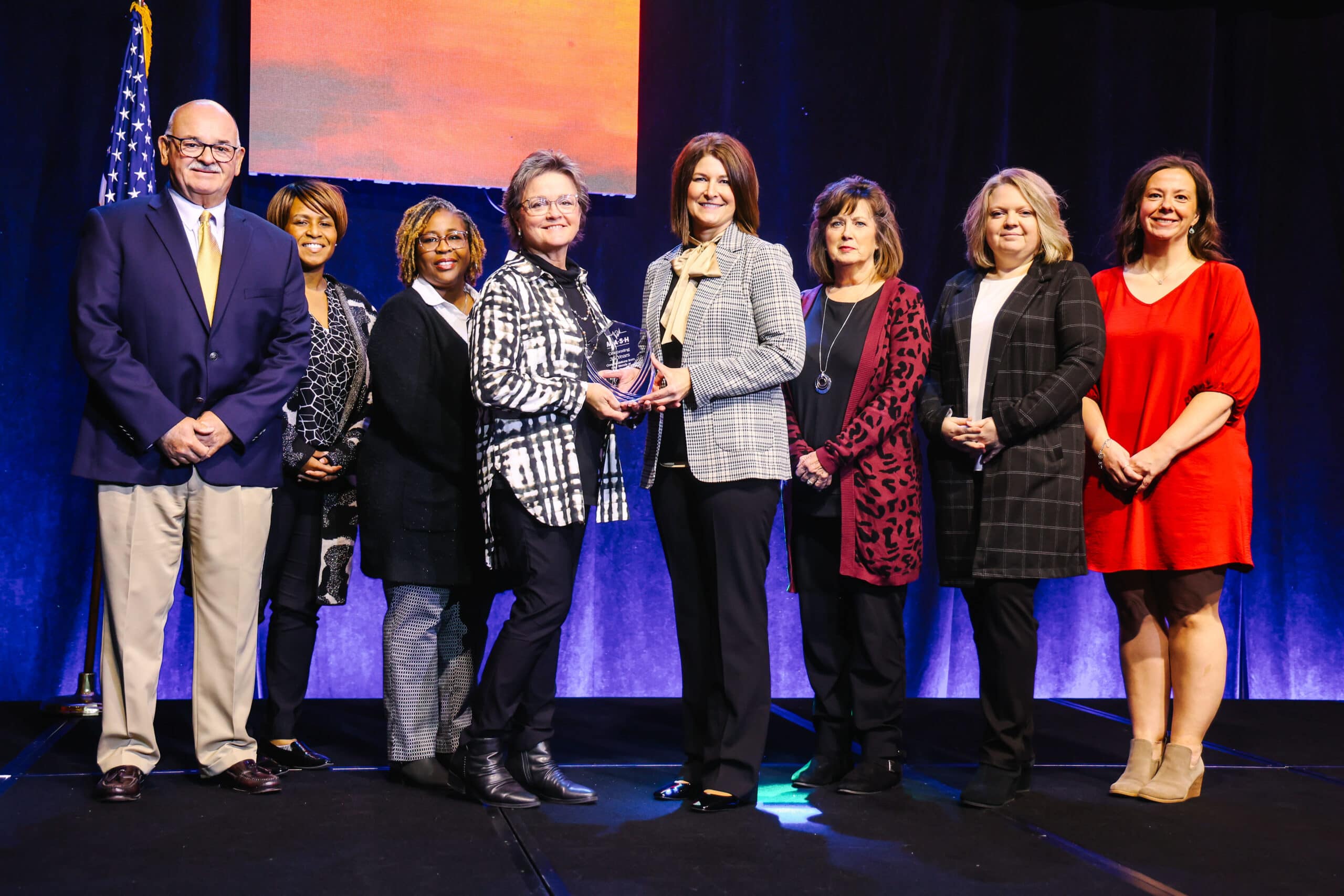UAMS Regional Campuses Mark 50th Anniversary
| The University of Arkansas for Medical Sciences (UAMS) in 2023 celebrated the 50th anniversary of its Regional Campuses, a network that has provided high-quality education and health care in rural and underserved communities throughout the state.
UAMS Regional Campuses, originally known as the Arkansas Area Health Education Center (AHEC) program, were founded in 1973 to encourage UAMS medical school graduates to remain in Arkansas, as well as to help address the state’s shortage and uneven distribution of primary care physicians.
AHEC programs began to take root across the nation after a 1970 report from the Carnegie Commission on Higher Education outlined the urgent need to address a nationwide shortage of health professionals. With the support of then-Gov. Dale Bumpers, UAMS leaders and health professionals, the Arkansas General Assembly appropriated $1 million to establish the state’s program.
The AHEC network initially was composed of six satellite campuses that together represented 74 of Arkansas’ 75 counties. In the early years, those sites focused on establishing clinics, student rotations and residency programs for primary care physicians, said Robin Howell, senior program manager for Regional Campuses.
“When you have all your trainees focused in Little Rock, the opportunities are more limited because there are so many students who need to complete their training at the same academic site,” Howell said. “But once you get into rural settings, opportunities both for clinical experiences and future practice options are wide open.”

UAMS offers residency training opportunities in a growing number of communities, including at the North Central Regional Campus in Batesville.Image by Bryan Clifton
Over the past 50 years, UAMS Regional Campuses have offered those opportunities in a growing number of communities. Today, it operates regional campuses in Batesville, Fayetteville, Fort Smith, Helena-West Helena, Jonesboro, Magnolia, Pine Bluff and Texarkana, as well as the upcoming reopening of one of the original sites in El Dorado. Several other communities host new rural residency training programs, including Berryville, Eureka Springs and Crossett.
Studies have shown that a majority of family physicians practice within 100 miles of their residency training site. Richard Turnage, M.D., vice chancellor for UAMS Regional Campuses, said this underscores the importance of providing educational opportunities in rural and underserved areas.
“We’ve developed an outstanding track record of attracting students into rural primary care,” he said. “I think it all starts with providing exposure to these communities.”
The impact of UAMS’ family medicine residency programs can be seen across the state, Turnage said. These programs produce about 50 new physicians each year, and 60% of them choose to stay in Arkansas for their clinical practice. Approximately half of all family physicians in rural Arkansas communities received their residency training from UAMS Regional Campuses, he said.
While the training of primary care physicians remains a key focus for UAMS Regional Campuses, its mission expanded in the 1980s after it received its first federal AHEC grant from the Health Resources and Services Administration (HRSA), an agency within the U.S. Department of Health and Human Services.
“Once we got the first federal AHEC grant, we started expanding into more interdisciplinary and interprofessional programs,” said Howell, who was hired in 1987 under that initial grant.
Today, UAMS Regional Campuses employ multidisciplinary faculty teams who provide training for a variety of non-physician areas of study, including Doctor of Pharmacy, physician assistant and nursing students, as well as others interested in allied health or behavioral health professions. In 2022 alone, Regional Campuses trained 268 health professions students and 157 residents, and it encouraged more than 13,000 high school and college students toward health careers. Regional Campuses’ clinics also provided interprofessional primary patient care services for 37,412 Arkansans.
“Our goal is to build out the entire workforce for health care,” Turnage said.
HRSA remains an important source of support. Regional Campuses recently received a $17.6 million renewal of the agency’s Medical Student Education program grant, which will help fund initiatives to train more students for careers in primary care.
The Arkansas Farm Bureau has also had a key role in the development of the state’s health care workforce. The organization is a longtime sponsor of the Medical Applications of Science for Health (MASH) program, a community engagement initiative created in 1988 to introduce high school students to careers in health care.
“We recognize the importance of focusing on the early end of the pipeline,” Howell said. “If you’re not working to constantly bring more students into that pipeline, then someday it will dry up. And it’s vital to specifically recruit students from rural and underserved communities that have the greatest workforce shortages, as it’s those students who will always be much more likely to return to such areas to practice.”

The MASH program is an important part of UAMS Regional Campuses’ effort to create a pipeline that connects young students with opportunities in the health professions.
Each year, MASH offers two-week summer camps in as many as 30 sites across the state. Its success inspired Regional Campuses to create other programs for youths who are interested in pursuing health careers, including the Community Health Applied in Medical Public Service (CHAMPS) program for younger junior high and high school students. Altogether, MASH and CHAMPS programs have reached more than 10,000 students since their inception.
One of Regional Campuses’ newest programs, Find Your Future in Healthcare, is an online virtual camp in which students from grades 10-12 participate in hands-on activities and learn about a variety of health care professions. The program, which started in 2021 as the COVID-19 pandemic forced cancellation of in-person events, will expand to include hundreds of high school students in 2024.
“The impact that Find Your Future has already had is amazing,” said Jesse Cargill, education coordinator at the UAMS North Central Regional Campus in Batesville. “The camp is designed to expose these students to health careers that they might not even know exist.”
This year, Arkansas Farm Bureau has reaffirmed its commitment to these programs, pledging $500,000 to Regional Campuses for creation of a fund to support UAMS’ health career camps. And during its annual convention in November, the Farm Bureau honored UAMS with a plaque that recognized the 35th anniversary of MASH’s founding.
“Farm families in rural areas understand the importance of ‘homegrown health care.’ The Farm Bureau saw the value of these camps early on, and they have been an amazing partner for more than three decades,” Howell said.
Turnage said UAMS has also been fortunate to gain the support and assistance of many health care organizations, including the Arkansas Rural Health Partnership and the Community Health Centers of Arkansas. He said UAMS’ residency training programs would not be possible without partner hospitals such as White River Medical Center in Batesville, Washington Regional Medical Center in Fayetteville and Northwest Medical Center in Springdale, St. Bernards Medical Center in Jonesboro, Jefferson Regional Medical Center in Pine Bluff, Baptist Health in Fort Smith, and Christus St. Michael Hospital and Wadley Regional Medical Center in Texarkana.
He also credited the state legislature for continuing to support UAMS’ mission. During the 94th session of the Arkansas General Assembly earlier this year, lawmakers approved a resolution to honor Regional Campuses’ 50th anniversary, noting “the tremendous health and economic impact the UAMS Regional Campuses have had at the local, regional and statewide levels.”
Looking toward the future, Turnage said the goal is to continue to improve the health and health care of all Arkansans, particularly those who live outside central Arkansas. He highlighted a number of initiatives intended to further that goal, including the creation of a food prescription program at the UAMS East Regional Campus in Helena-West Helena and the opening of satellite transplant clinics in several cities.
Regional Campuses are also in the process of analyzing decades of data to better understand the health care and workforce needs of rural and underserved areas, Turnage said. This will inform UAMS’ strategies not only for educational programs, but also for clinical services in these communities.
Marcia Byers, Ph.D., RN, senior director of Regional Campuses, said she looks forward to seeing how these projects build on the progress the network has made over the past 50 years.
“I’m so excited to be a part of this momentous anniversary and proud to continue to serve Arkansans,” she said. “The impact we have through our programs will continue to expand for decades to come.”
